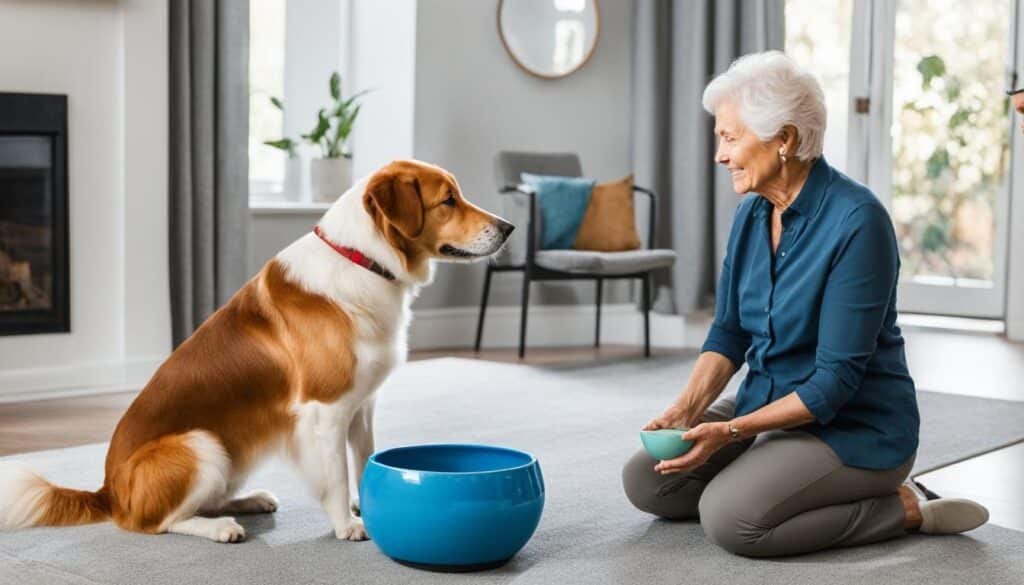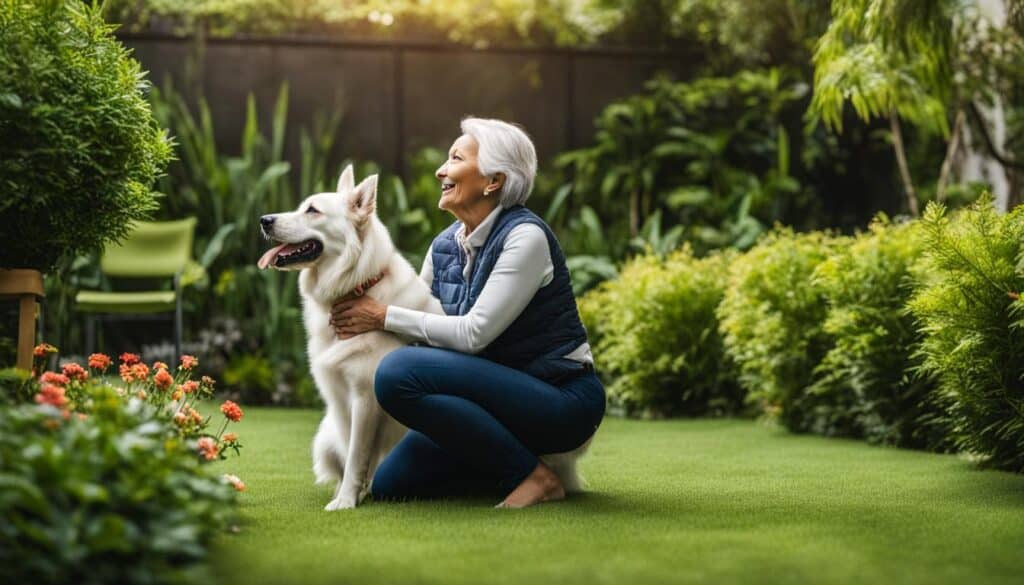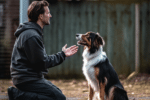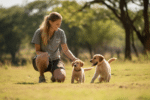Training Strategies for Older Dogs: Adapting to Age

Despite what you may have heard, a dog’s willingness to learn does not disappear with age. Older dogs still have a trick or two left up their sleeves, and if you challenge and engage them in a training routine, their eagerness to learn will shine through. Age will only be an obstacle in training your dog if you allow it to be.
A senior dog might take a bit longer to understand what you’re trying to accomplish since their habits will be more entrenched than those of a younger dog. But once they realize you’ve found an opportunity to spend lots of time with them, their cooperation is ensured!
Training a senior dog is important for their overall wellbeing. Aging dogs may experience physical and cognitive decline, but challenging them with training can slow down these changes and keep them mentally and physically active. Training can also help break unwanted habits and improve their behavior, making them more pleasant companions in the household.
To successfully train an older dog, it’s important to have a plan and approach that is tailored to their individual needs. Start by addressing any existing bad habits or unwanted behaviors through positive reinforcement. Be patient and use positive reinforcement to reinforce good behavior. Break down the training tasks into smaller parts and gradually build up to more complex commands. Utilize a crate for house training and stick to a consistent schedule. Consider attending an obedience class for additional guidance and expertise. Finally, keep the training sessions fun and engaging by teaching new tricks and adding variety to the training routine.
As dogs age, their needs and abilities change. It’s important to take into account their physical limitations, cognitive decline, and changes in behavior when training older dogs. Conduct a health check to ensure they’re fit for training and consider any underlying health issues that may affect their training abilities. Be patient and adapt the training techniques to suit their abilities. Provide regular exercise and mental stimulation tailored to their individual needs. Building a strong bond through training can also help address any existing behavioral issues.
Before starting the training process, ensure that your home is prepared and safe for your senior dog. Stock up on essential supplies like a collar or harness, leash, clicker, and training treats. Create a predictable schedule for meals, bathroom breaks, exercise, and training sessions. Ensure that everyone in the household is on the same page when it comes to training techniques and consistency. Start the training process slowly, allowing your dog to adjust to their new environment and build trust with you.
When training an older dog, it’s important to focus on the positive and be patient. Use positive reinforcement techniques, rewards, and praise to motivate and encourage desired behaviors. Keep training sessions short and focused, adapting the intensity and difficulty of exercises to your dog’s abilities. Create a distraction-free environment to help them stay focused. Utilize a quiet space in your home to minimize noise-related anxiety. Follow a daily schedule for meals, bathroom breaks, exercise, and training. And remember, consistency is key in training older dogs.
Training older dogs can be a rewarding experience for both the dog and the owner. With the right approach, patience, and consistency, any dog of any age can learn and adapt to new behaviors and commands. By addressing their individual needs and tailoring the training to their abilities, you can strengthen the bond with your senior dog and enhance their overall wellbeing. Training should be a positive and enjoyable experience for both you and your furry friend. Remember to seek professional help if needed, and most importantly, have fun training your older dog.
Importance of Training for Senior Dogs
Training for Older Dogs, Senior Dog Training, Age-Appropriate Training
Training a senior dog is vital for ensuring their overall wellbeing and quality of life. As dogs age, they may experience physical and cognitive decline, which can impact their behavior and overall abilities. However, challenging them with age-appropriate training exercises can help slow down these changes and keep older dogs mentally and physically active.
One of the key benefits of training senior dogs is its ability to break unwanted habits and improve their behavior. By introducing consistent training routines, older dogs can learn new commands and behaviors that make them more pleasant companions in the household. Training also provides mental stimulation and can help alleviate boredom, which is crucial to the emotional health of senior dogs.
Additionally, training helps foster a strong bond between the dog and their owner. It promotes communication, trust, and respect, which are essential for a harmonious relationship. A well-trained senior dog is more likely to respond positively to commands and exhibit good behavior both at home and in public settings.
The key to successful training for senior dogs lies in adapting the training methods to accommodate their changing abilities and limitations. Patience, consistency, and positive reinforcement are crucial in achieving desired results.
Benefits of Training for Senior Dogs:
- Stimulation of cognitive function
- Maintenance of physical fitness
- Improvement in behavior and manners
- Enhancement of the bond between the dog and owner
Age-Appropriate Training Exercises
| Training Exercise | Description |
|---|---|
| Sit | Teaching the dog to sit on command, a fundamental obedience skill |
| Stay | Training the dog to remain in one place until released, promoting self-control |
| Down | Teaching the dog to lie down on command, promoting relaxation and calm behavior |
| Come | Teaching the dog to come when called, ensuring their safety and control in various situations |
| Leave it | Training the dog to leave objects alone, promoting safety and preventing destructive behavior |
These exercises are just a starting point and can be customized based on the individual needs and abilities of the senior dog. It’s important to consult with a professional trainer or behaviorist to develop a training plan that suits your dog’s specific requirements.
Tips for Training Older Dogs
To successfully train an older dog, it’s important to have a plan and approach that is tailored to their individual needs. Here are some valuable tips to help you with training your senior canine companion.
Addressing Bad Habits and Unwanted Behaviors
Start by addressing any existing bad habits or unwanted behaviors through positive reinforcement. Identify the specific behaviors you want to change and redirect your dog’s attention towards more desired actions. Use rewards and praise to reinforce good behavior and discourage unwanted actions.
Breaking Down Training Tasks
Breaking down the training tasks into smaller parts can make it easier for older dogs to learn and understand. Start with simple commands and gradually progress to more complex ones. This gradual approach allows your dog to build confidence and ensures that they grasp each step before moving on to the next.
Utilizing a Crate and Consistent Schedule
A crate can be a helpful tool for house training older dogs. It provides them with a safe and comfortable space while preventing accidents indoors. Additionally, sticking to a consistent schedule for feeding, bathroom breaks, exercise, and training sessions helps older dogs establish a routine and understand what is expected of them.
Consider Obedience Classes
If you feel that you need additional guidance and expertise in training your older dog, consider attending obedience classes. These classes provide professional instruction and give you the opportunity to work with experienced trainers who can offer personalized advice and techniques to address any training challenges you may encounter.
Keeping Training Fun and Engaging
Training sessions should be enjoyable for both you and your dog. Incorporate fun activities, teach new tricks, and add variety to the training routine. By keeping the training sessions interesting and engaging, you’ll keep your senior dog motivated and eager to learn.
Training older dogs requires patience, consistency, and a customized approach. By following these tips, you can help your senior dog learn new behaviors, strengthen your bond, and ensure their overall well-being.
Understanding the Needs of Senior Dogs
As dogs age, their needs and abilities change. When training older dogs, it’s crucial to take into account their physical limitations, cognitive decline, and changes in behavior. By understanding these needs, you can tailor your training approach to ensure it is age-appropriate and effective.
To begin, it is advisable to conduct a health check to ensure your senior dog is fit for training. Consider any underlying health issues that may affect their training abilities, such as arthritis or hearing loss. Consulting with your veterinarian can provide valuable insights and guidance.

Next, be patient and adapt the training techniques to suit their abilities. Older dogs may take a little longer to learn new commands, but with consistent practice and positive reinforcement, they can still make progress. Break down the training tasks into smaller, manageable steps, and gradually build up to more complex commands.
Providing regular exercise and mental stimulation is also essential for senior dogs. Tailor their physical activities to their individual needs, considering their overall health and energy levels. Engaging them in activities such as puzzle toys, scent games, or gentle walks can help keep their minds sharp and prevent boredom.
Building a strong bond through training can also help address any existing behavioral issues. Senior dogs may develop certain habits or anxieties over time, and a structured training routine can provide them with stability and reassurance.
“Training older dogs requires patience and understanding. By adapting the training techniques to suit their needs and building a strong bond, you can help them lead happy and fulfilling lives.” – Dr. Jane Adams, Canine Behavior Expert
Key Points to Remember
- Conduct a health check to ensure your senior dog is fit for training.
- Adapt training techniques to suit their abilities and learning pace.
- Provide regular exercise and mental stimulation tailored to their needs.
- Build a strong bond through training to address behavioral issues.
Getting Started with Dog Training
Before you begin training your older dog, it’s important to create a safe and prepared environment at home. Start by stocking up on essential supplies such as a collar or harness, leash, clicker, and training treats. These items will ensure you have the necessary tools to effectively communicate and reward your dog during training sessions.
Next, establish a predictable schedule for meals, bathroom breaks, exercise, and training sessions. Consistency is key in training older dogs, so having a structured routine will help them understand what is expected of them. It also allows them to anticipate specific times for training, which can make the process smoother and more enjoyable for both of you.
Additionally, it’s important to ensure that everyone in the household is on the same page when it comes to training techniques and maintaining consistency. Having a unified approach will prevent confusion and provide a clear message to your dog during the training process.
Lastly, start the training process slowly and gradually. Older dogs may take some time to adjust to their new environment and build trust with you. Patience and understanding are key as they navigate through the learning process. Your senior dog will appreciate the opportunity to adapt at their own pace and develop a stronger bond with you.
Creating a positive and supportive training environment will set the stage for successful training sessions with your older dog. Remember to be patient, consistent, and understanding throughout the process, and most importantly, have fun!
How to Train an Older Dog: Tips for Success
When it comes to training older dogs, a positive and patient approach is essential. Utilizing age-appropriate training techniques and strategies can help you effectively train your senior canine companion. Here are some valuable tips to ensure a successful training experience:
1. Positive Reinforcement
Use positive reinforcement techniques to motivate and encourage desired behaviors. Reward your dog with treats, praise, and affection when they exhibit good behavior. This positive reinforcement will help them associate training with positive experiences, making them more eager to learn and participate.
2. Short and Focused Sessions
Keep training sessions short and focused to accommodate your older dog’s attention span. Older dogs may have limited stamina and mental endurance, so breaking down training sessions into smaller, manageable segments will help them stay engaged and motivated.
3. Adapt Intensity and Difficulty
Adapt the intensity and difficulty of exercises to match your dog’s abilities. Gradually increase the difficulty level as they progress and gain confidence. This gradual approach will prevent frustration and ensure a continuous sense of achievement for your senior dog.
4. Create a Distraction-Free Environment
Minimize distractions during training sessions to help your older dog stay focused. Choose a quiet and comfortable space in your home where your dog can concentrate without being overwhelmed by noise or external stimuli.
5. Stick to a Daily Schedule
Establish a consistent daily schedule for meals, bathroom breaks, exercise, and training sessions. Older dogs thrive on routine, and having a predictable schedule will help them feel secure and reduce any anxiety or confusion they may have.
6. Consistency is Key
Consistency is paramount when training older dogs. Use the same commands, gestures, and reinforcement techniques consistently to avoid confusion and build a strong understanding between you and your dog. Regular practice and repetition will reinforce desired behaviors and make training more effective.
| Training Tips for Older Dogs | Benefits |
|---|---|
| Use positive reinforcement | Increases motivation and encourages desired behaviors |
| Keep sessions short and focused | Maintains engagement and prevents mental fatigue |
| Adapt intensity and difficulty | Promotes continuous progress and a sense of achievement |
| Create a distraction-free environment | Enhances focus and concentration during training |
| Stick to a daily schedule | Establishes routine and reduces anxiety |
| Consistency is key | Builds understanding and reinforces desired behaviors |
By following these tips and adapting your training approach to suit your older dog’s abilities, you can create a positive and successful training experience. Remember, every dog is unique, so tailor your training methods to their individual needs and capabilities. With patience, consistency, and a bit of fun, you can help your senior dog master new skills and strengthen your bond along the way.

Conclusion
Training older dogs is a fulfilling journey that benefits both the dog and their owner. Regardless of age, dogs can learn and adapt to new behaviors and commands when approached with the right mindset. Patience and consistency are key in successfully training senior dogs, allowing them to thrive and strengthen their bond with their owners.
By tailoring the training to address their individual needs and abilities, we can ensure that our senior dogs experience an improved quality of life. Age-appropriate training can help stimulate their minds, keeping them mentally and physically active as they age. Additionally, addressing any existing behavioral issues through positive reinforcement training can result in more well-behaved and enjoyable companions within our households.
During the training journey, it is important to remember that each dog is unique. Seeking professional help if needed can provide expert guidance tailored specifically to your senior dog’s needs. Through consistent training and a positive and enjoyable training experience, we can create a strong and lasting connection with our older canine friends.
FAQ
Does a dog’s willingness to learn diminish with age?
No, a dog’s willingness to learn does not disappear with age. Older dogs can still learn new tricks and engage in training routines.
Why is training important for senior dogs?
Training is important for senior dogs because it helps keep them mentally and physically active, slows down age-related decline, and improves their behavior and overall wellbeing.
How should I approach training an older dog?
When training an older dog, it’s important to have a tailored plan that addresses their individual needs. Start by addressing any existing bad habits, use positive reinforcement, break down tasks, and consider attending obedience classes for guidance.
What should I consider when training older dogs?
When training older dogs, consider their physical limitations, cognitive decline, changes in behavior, and any underlying health issues that may affect their training abilities. Regular exercise, mental stimulation, and a strong bond through training are important.
How should I prepare my home for a senior dog training?
To prepare your home for senior dog training, stock up on essential supplies, create a predictable schedule, ensure consistency among household members, and create a distraction-free environment.
What techniques should I use when training an older dog?
When training an older dog, focus on the positive and be patient. Use positive reinforcement techniques, rewards, praise, keep sessions short and focused, and create a distraction-free and quiet environment.
Can any dog of any age learn new behaviors and commands?
Yes, any dog of any age can learn new behaviors and commands with the right approach, patience, consistency, and tailoring the training to their individual needs and abilities.






